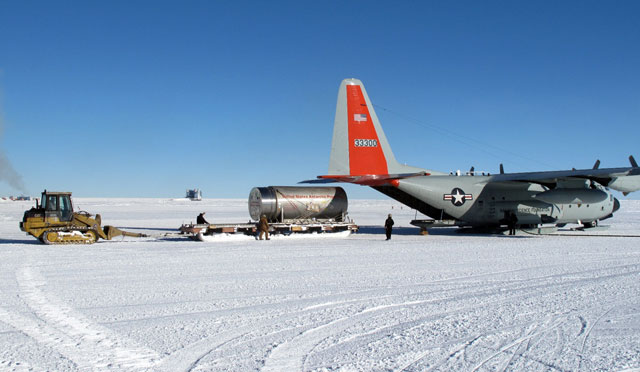|
Full of cold airSouth Pole Station makes the most of liquid helium supplyPosted June 22, 2012
Helium isn’t just good for party balloons. At one of the coldest places on the planet — where the temperature bolts down to minus 100 degrees Fahrenheit during the winter months — liquid helium has been used to super-cool special telescopes designed to peer into the mysteries of the early universe. However, the use of bulk liquid helium may also become a thing of the past, as the astrophysical experiments at the South Pole Station Helium is a limited resource that promises to become even scarcer and more expensive in the future. A bipartisan bill being considered in the U.S. Senate The South Pole Station has done its part over the last decade or so to stretch out the nation’s helium supply, which is used in everything from the manufacture of fiber optics and microchips to cooling the superconducting magnets used in MRI machines. The zero boil-off system now at the South Pole ensures that almost no helium is lost to the atmosphere. Water, of course, has a boiling point of 100 degrees Celsius, transitioning from a liquid to a gas. Helium also has a boiling point, but a wee bit lower — minus 269C. On the Kelvin scale, that’s about 4.2 degrees above absolute zero, the temperature at which all molecular motion stops. The temperature of outer space is about 3 Kelvin. The telescopes at the South Pole do not operate in the visible light spectrum, but instead measure microwave radiation. The telescope sensors use superconductive materials that must be cooled down to 250 milliKelvin, just a quarter of a degree above absolute zero, to study the cosmic microwave background, often described as an afterglow of the Big Bang Liquid helium has been an integral part of cryogenic techniques since astrophysical experiments began at the South Pole in the 1980s, according to Paul Sullivan, South Pole Station manager of science support. In the nascent days of such research, a scientist would set up a temporary observatory away from the main station, drag a 250-liter container of helium called a dewar to the site, and get about a week’s worth of data. “That was the early days of what they called Pomerantz Land,” said Sullivan, referring to the late Martin Pomerantz By the 1990s, the first bulk shipments of liquid helium started arriving at the South Pole. Sullivan said that during his first season at the station in 1996-97, there were three 4,000-liter containers sitting outside under a metal arch. The helium was tapped until it was all gone, usually running out before the end of the winter observing season, though during his season as the cryogenics technician he was able to get the helium to last until the next resupply. That resupply in recent days involved transporting the liquid helium by ship to Port Lyttelton near Christchurch, New Zealand, in huge 11,000-gallon refrigerated transports. From there, it was transferred into two gigantic 3,500-gallon dewars, which then were loaded into a U.S. Air Force C-17 for transport to McMurdo Station The logistics costs certainly inflate the basic cost of helium, with raw prices on the rise as supplies get squeezed on the world market. The underground Amarillo reservoir reportedly accounts for about 30 percent of the world market. “It’s definitely not cheap, and it was a lot cheaper back then [in the 1990s],” Sullivan said.1 2 Next |



For USAP Participants |
For The Public |
For Researchers and EducatorsContact UsU.S. National Science FoundationOffice of Polar Programs Geosciences Directorate 2415 Eisenhower Avenue, Suite W7100 Alexandria, VA 22314 Sign up for the NSF Office of Polar Programs newsletter and events. Feedback Form |



